Do you ever find yourself or your marketing team struggling with visual decisions about your hotel’s website, email newsletters, social media posts, marketing ads, or print collateral? Do you think your output sometimes appears disjointed or too similar to your competitors? Do you feel a lot of uncertainty about the result of a project whilst commissioning work from a designer?
If you answered yes to any of these questions, then this article is for you. It explains how to create effective Brand & Visual Identity Guidelines and why they are important. You can distribute your guidelines internally, and to external partners like P3, to achieve consistency across your hotel’s output.
With clear and informative guidelines, you will be more confident in your hotel’s visual communication style, improve brand recognition, and build guest trust and loyalty.
Brand Identity Vs. Visual Identity
To begin, let’s understand the difference between brand identity and visual identity.
Brand identity is the ‘what’, ‘who’ and ‘why’ of your guidelines. For instance, what is your hotel’s story or personality? What are your hotel’s values or purpose? Who are your target audience or guests? Why would someone want to stay at your hotel? The answers to these questions provide vital information for the creation of informed, authentic, and logical guidelines.
Visual identity is the ‘how’ of your guidelines. How will you visually communicate the answers to your brand identity questions? How will you differentiate your hotel from others? What is your unique visual DNA? How will you use your logo, graphics, colours, typography, imagery and photography to facilitate memorable and honest connections with your guests? You must define how to translate your brand’s ‘what’,‘ who’ and ‘why’ into a consistent, unique visual language that people can clearly interpret.
Brand & Visual Identity Guidelines should be carefully created and strictly adhered to. It is best practice to hire a graphic/visual designer to help create them for you. You should inform them that you need your guidelines to be holistic in approach. Request that your guidelines provide insights into your brand identity and instructions for the execution of your visual identity across various contexts: both for print (brochures, business cards, keycards etc.) and digital (website, social media, email newsletters etc.).
What to Include in Your Brand Guidelines
So what makes for effective guidelines? To be successful they should be practical, straightforward, and provide step-by-step instructions on the 'Do’s and Don’ts' of multiple aspects of your visual identity.
We recommend dividing your guidelines into the following sections:
1. Brand Identity
This section may vary for each hotel. For example, it might contain information about your story or history, goals or purpose, personality, values, unique selling points, and target guests. The main goal here is to communicate your hotel’s distinctive qualities and characteristics. Only write about what is relevant to your hotel brand’s identity.
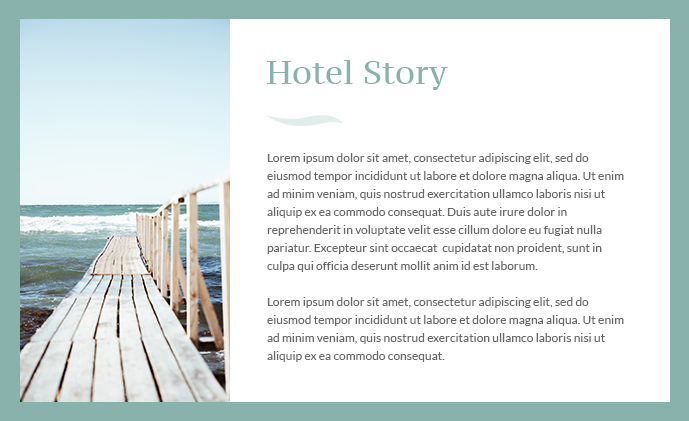
2. Logo Variations
Demonstrate your logo variations and outline its 'Do’s & Don’ts'. You may want to define rules about how the logo appears against different colour backgrounds and styles of imagery or photography. It is best to annotate each logo variation with rules and example use cases.
In terms of 'Do’s', we recommend illustrating the logo’s minimum surrounding space measurements and how it should appear at different scales. Some logos may also have an icon or emblem with specific use cases. Lastly, it is good to demonstrate as many incorrect uses of the logo’s 'don’ts' as possible. Demonstrate even the most obvious 'don’ts'. You just can’t be certain about what other people might think is acceptable.
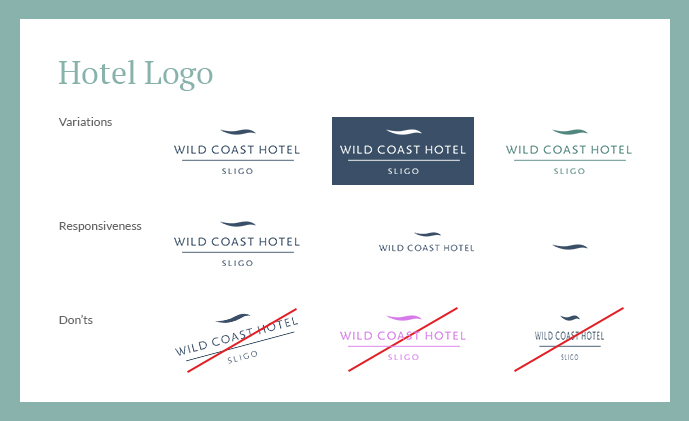
3. Colour Palette
Provide information about your brand identity’s colour palette. Your brand will certainly have a primary colour palette and possibly even a secondary or extended colour palette. Each colour should be labelled with its corresponding colour codes for print and digital. These are usually its Pantone shade, CMYK values, RGB values and Hex code. You may even want to give information about where or how each colour can or can’t be used.
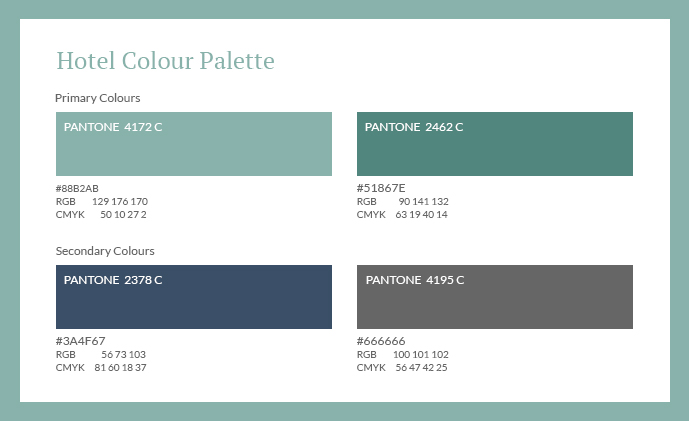
4. Typography
Showcase your brand identity’s typographic styles. You may have different fonts that are used for headings, sub-headings, body text and captions. You may also use an entire typeface or font family in your visual communication. So it’s best to indicate which font weights are permitted and to provide instructions on the use of each one. It’s good to give as much guidance as possible to avoid inconsistency in your design output.
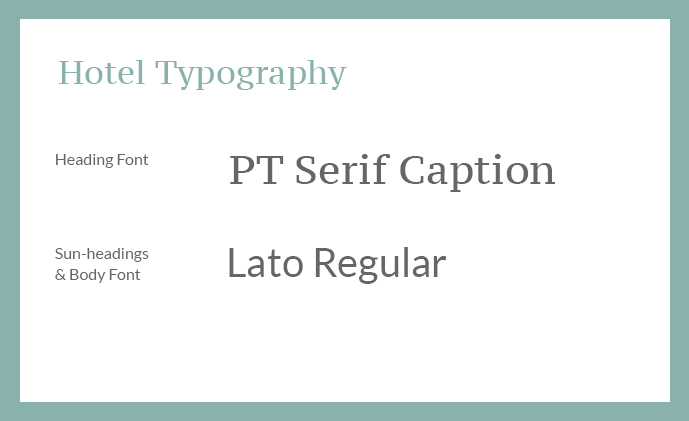
5. Photography
Guidelines on the use of photography are very important. People subconsciously perceive a lot about a hotel from its use of photography. We recommend demonstrating what styles of photography are permitted and which ones are not. If relevant, demonstrate how your photography interacts with graphics or if any specific filters should be used. Illustrate the 'Do’s and Don’ts' with examples. A rule of thumb is to avoid cliché or overly staged photography. The more authentic or natural the photography, the better.
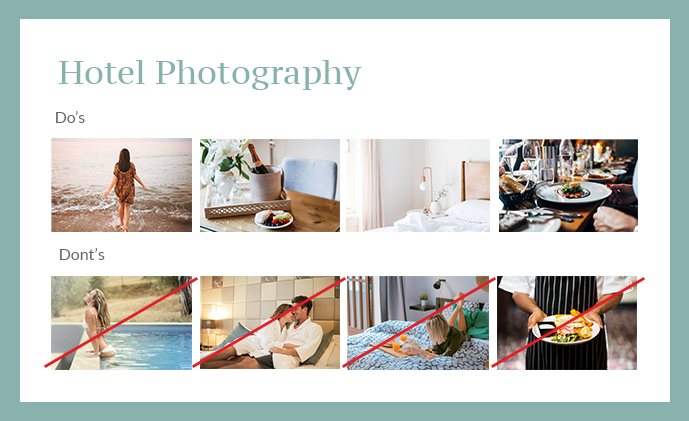
6. Print & Physical Items
This section gives you a chance to show examples of how your visual identity can be used for print projects and on physical items. This might be brochures, menus, stationery, robes, umbrellas, uniforms, products and information signs, etc. Choose about 5-10 examples and make sure that they showcase a wide enough breadth of your visual identity’s creative potential.
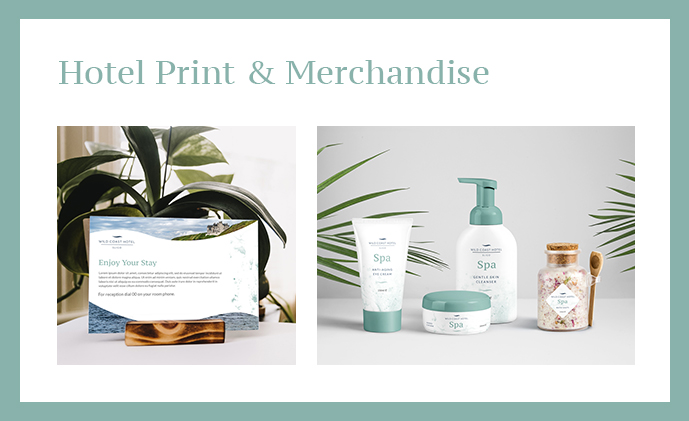
7. Graphics, Textures & Illustrations
Any imagery used that is not photographic in nature should be demonstrated in this section. For example, your hotel might use specific textures or patterns as decorative elements of your visual identity. You may even employ the use of custom illustration (although rare for hotels) and icons (more likely). Include visual examples and instructions for their different use cases if relevant.
8. Digital Appearance
The digital section of your guidelines should primarily include details about your website’s appearance, social media styles, and email newsletter templates. However, anything that a guest will interact with online can be included here as well.
You can elaborate on the appearance of your website by including some examples of its user interface styles. For example, primary versus secondary buttons, form styles, and icons. You can even show some of their interactive states (e.g. mouse hover or disabled). Don’t get too bogged down in user interface details though. Generally, a user interface is part of a big design system that web designers should have access to elsewhere (via website design files or HTML/CSS stylesheets, etc.).
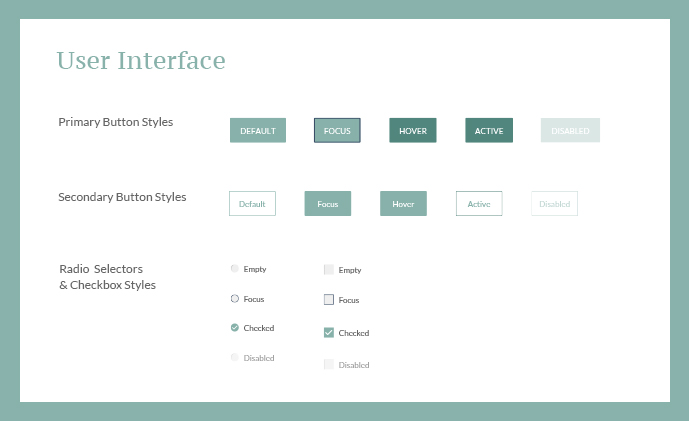
9. Visual Concept & Voice
If relevant, you can choose to explain the concept behind your visual identity. If specific colours, shapes, textures or typographic styles have a conceptual meaning, summarise it in a way that helps the reader understand the logical thinking behind design choices.
We also recommend that you explain the tone of voice of your brand’s written communication. Is it formal or casual? Is it energetic or relaxed? What sort of adjectives or verbs do you use to communicate? We recommend providing a few samples and maybe accompanying them with some 'Do’s and Don’ts'.
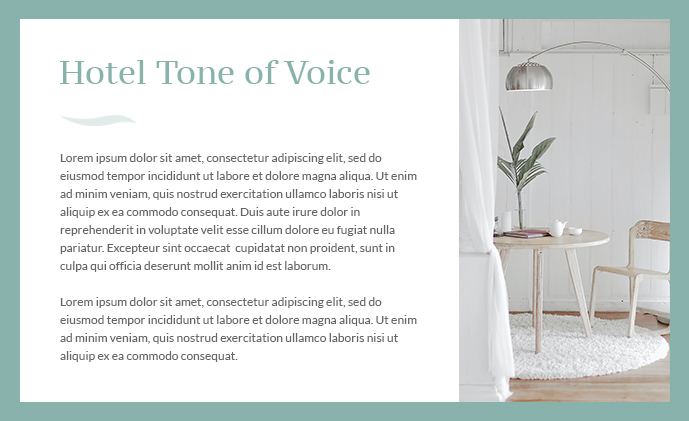
Make design decisions more easily
Once you have completed your hotel’s Brand & Visual Identity Guidelines, you can use it as a reference for all your communication projects. It can be shared internally amongst team members and externally with other professionals for ease of collaboration.
For example, whilst working with P3, you can give us your brand guidelines before we start developing your booking engine or online check-in. This way, there can be no doubt that our product will match your brand in a way that is in line with the rest of your online presence.
You will have full confidence in the work commissioned, with little to no feedback required on things like button colours and font styles. This will facilitate ease in decision making whilst reviewing our products for release.
Conclusion
With informative Brand & Visual Identity Guidelines, your hotel’s output will remain consistent and recognisable. This visual consistency will build your credibility amongst new and existing guests and ultimately augment their entire experience.
Guests will be more likely to frequently affiliate themselves with your hotel if they can anticipate exactly what your brand stands for through its consistent visual choices. You should aim to facilitate authentic connection with your guests, and the best way to do this is through an easily interpretable brand that does your hotel’s offering justice.

